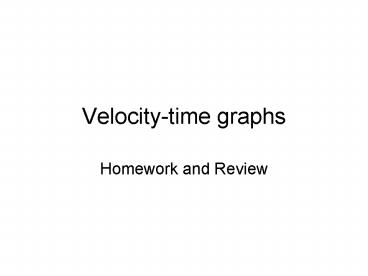Velocity-time graphs PowerPoint PPT Presentation
1 / 28
Title: Velocity-time graphs
1
Velocity-time graphs
- Homework and Review
2
Velocity-time graphs
3
Questions
- Which sections indicate forward motion?
- Which sections indicate constant acceleration?
- At what velocity does the vehicle travel at the
500 second mark?
4
Question 1
- Assume that each graph is a position-time graph
(vertical units in meters, horizontal in seconds) - Determine the velocity of the object at the 11.5
second mark
5
Question 2
- Still assuming graphs are position time
- Calculate the overall displacement for each graph
6
Question 3
- Assume it is a position- time graph
- What is the overall velocity?
7
Question 4
- Assume graph is a position-time graph
- Describe the motion in the 2nd section of each
graph. - Indicate direction, CV or ACC, faster, slower
8
Question 5
- Assume graph A is a velocity-time graph.
- Describe the motion in each of the first 3
sections of the graph. - Indicate direction, ACC or CV, faster or slower
9
Graph handout
- 10
10
Homework Handout 2
- Name, Class Period,
- Add title Homework Handout 2
- For each section of the given graphs, indicate
- - direction (positive, negative, stopped)
- - type of motion (constant or non-constant vel)
- - if constant rate of motion (high, middle, low)
- - if NC, is object getting faster or slower
11
For the following graphs
- Copy down to your paper
- Divide the motion up into sections
- Each section should only have one type of motion
- Indicate direction, velocity type, rate of
motion or how the velocity changes
12
Problem 1
13
Problem 2
14
Questions
- What do the vertical numbers represent?
- What does a horizontal line represent on this
graph? - What does a sloping line represent on this graph?
15
- For each section of the P-T graph, determine
- Direction of motion
- Constant velocity or constant acceleration
- If accelerating, is object getting faster or
slower
16
- For each section of the V-T graph, determine
- Direction of motion
- Constant velocity or constant acceleration
- If accelerating, is object getting faster or
slower
17
- For each velocity-time graph, draw the equivalent
position time graph
18
Do Now
- Describe the motion that produced the following
V-T graph
V (m/s)
4
30
t (s)
5
10
20
13
24
-5
19
Assignment based on walking in front of motion
detector
- Some need to get the graph
- Once graph is in your possession
- Divide up into section, with only one type of
motion for each section, describe motion - Identify one section with constant velocity,
calculate by using slope off P-T graph - Identify one section with constant acceleration,
calculate by using the slope off V-T graph - Find the overall velocity
20
For this graph, what are the overall Displaceme
nt Distance Velocity
21
Problem 5
- Describe the motion in the following V-T graph.
Then find the overall velocity of the first 2
sections
8s
11s
-18 m/s
22
V-T graph
- Describe motion
V
t
23
- Given the following Velocity-Time graph, indicate
the type of motion in each section. Include
information on direction, acceleration or
constant velocity
24
- Find the overall velocity for the first 2
sections in the V-T graph
25
Example Q. 3
- A) Draw a P-T graph that shows an object
remaining at rest for 15 seconds - B) Draw a V-T graph that shows an object speeding
up backwards at a uniform acceleration for 15
seconds
26
What to do for each graph
- For each section with the same type of motion,
you should be able to determine - Is the object moving positive, negative, or
stopped - Is the motion constant or not?
- If constant, is the rate of motion fast, average
or slow? - If not constant, is the object getting faster or
slower?
27
V-T graph
28
Identify motion for each part of the V-T graph
V (m/s)
T (m/s)

